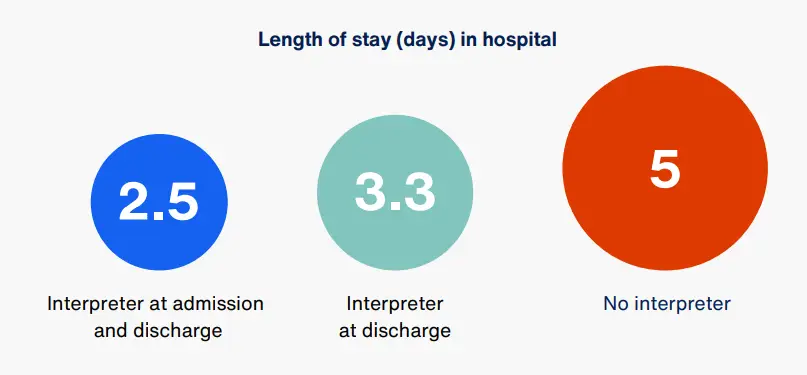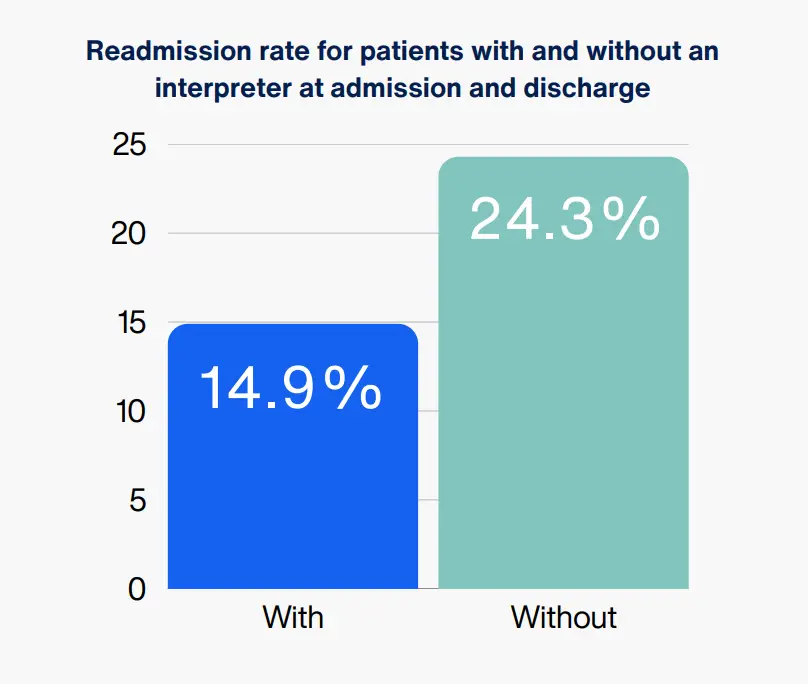Nearly 26 million people in the U.S. have limited English proficiency (LEP). When patients and providers can’t communicate, misunderstandings increase, medical errors happen, and costs rise. Professional interpreters help bridge this gap, ensuring patients receive fair, high-quality care. This not only improves health outcomes but also supports value-based care (VBC) goals.
In this article, we’ll explore highlights from our eBook, Bridging the Language Gap in Value-Based Care. We’ll discuss how professional interpreting services help healthcare teams cut readmissions, shorten hospital stays, and protect revenue under programs like the Hospital Readmissions Reduction Program (HRRP).
What Is Value-Based Care?
Value-based care (VBC) is a healthcare payment model that rewards providers for improving patient outcomes and lowering costs. Instead of paying based on the number of services delivered, VBC focuses on rewarding results. Providers are held accountable for outcomes and are incentivized to prevent avoidable expenses.
For healthcare leaders, professional interpreting services are a smart strategy. They help keep patients healthier and protect financial performance.
Why Language Must Be Part of the VBC Conversation
About 8.5% of people in the U.S. have LEP. Without proper language support, these patients often face serious challenges accessing care. Research shows that language barriers can lead to medical errors, longer hospital stays, and higher readmission rates. For instance, LEP patients who had surgery stayed a median of 3 days compared to 2 days for English-speaking patients. They are also more likely to be readmitted within 7 or 30 days after leaving the hospital. Furthermore, patients who do not fully understand their care instructions report lower satisfaction. On the financial side, hospitals with too many readmissions have faced nearly $1.9 billion in penalties since 2012 under the HRRP.
How Interpreting Improves Outcomes
Professional medical interpreters make a measurable difference, especially during admissions and discharge. Here are a few peer-reviewed studies that show how interpreting improves quality outcomes for patients, visualized, from our eBook:
Reduced Length of Stay
Average stays dropped from 5.06 to 2.57 days when professional interpreters were used at admission and discharge.

Lower Readmissions
Readmission rates dropped from 24.3% to 14.9% when professional medical interpreters were available to support patients at admission and discharge.

Patient Satisfaction
Patients are 2.3 times more likely to rate care highly when professional interpreters are involved.

ROI of Value-Based Care
Most healthcare workers know that medical interpreting services provide value to their LEP patients. However, the challenge is that the service is often seen as a cost center.
To make a strong case for interpreting services, managers of language service programs should track LEP patients as a unique cohort. Comparing their outcomes to English-speaking patients on quality measures like length of stay, readmission rates, patient satisfaction, and cost savings will reveal key opportunities for improvement and highlight return on investment.
Benefits of Implementing Professional Interpreting Services
- Cut down on readmissions
- Prevent costly care errors per patient.
- Save Medicare revenue by avoiding readmission penalties.
- Boosts patient satisfaction
Steps to Maximize ROI with Interpreting Services
Healthcare leaders can adopt a few proven strategies to embed language support into their value-based care efforts. These practical steps help ensure that interpreting services are fully integrated into workflows and performance tracking.
- Standardize LEP identification in the EHR. Record language preferences and interpreter needs during registration.
- Create LEP-specific dashboards and reports. Use them to track disparities and monitor progress.
- Stratify quality measures by language. Apply to key metrics like readmission rates, length of stay, and patient satisfaction.
- Include LEP metrics in value-based contracts. Align language access goals with financial incentives.
These actions help improve care quality, raise patient satisfaction, and protect revenue.
Value-Based Care for Success
Tracking LEP patient outcomes, providing professional interpreters at key care points, and integrating language metrics into value-based care strategies can lead to better outcomes and stronger financial results.
Contact us today to learn how Boostlingo can help you improve outcomes and reduce costs.



